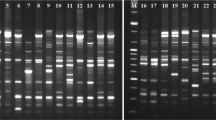Abstract
The random amplified polymorphic DNA (RAPD) technique offers a useful tool to detect DNA polymorphisms. It can also be used to distinguish different clones and cultivars. We have developed a comprehensive RAPD-based procedure for the routine molecular typing of various plants. Here we report the application of this technique for the correct identification of six hazelnut cultivars (Corylus avellana) widespread in the Campania region (south Italy). The analysed hazelnut cultivars were successfully distinguished by their RAPD fingerprints using the DNA primers U2, U3, U4, U11 and U14. However, in each cultivar we observed very low genetic heterogeneity among the clonal variants. Since this technique is among the simplest and easiest methods used to fingerprint DNA, it could be easily transferred to less sophisticated laboratory infrastructures (e.g. outstations of crop regulatory agencies).
Similar content being viewed by others
Author information
Authors and Affiliations
Additional information
Received: 20 December 1997 / Revision received: 6 August 1998 / Accepted: 13 November 1998
Rights and permissions
About this article
Cite this article
Galderisi, U., Cipollaro, M., Di Bernardo, G. et al. Identification of hazelnut (Corylus avellana) cultivars by RAPD analysis. Plant Cell Reports 18, 652–655 (1999). https://doi.org/10.1007/s002990050637
Issue Date:
DOI: https://doi.org/10.1007/s002990050637




